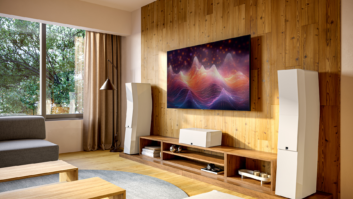We have been both the beneficiaries and the victims of the first significant change in our television industry’s history: the transition from the standard 4:3 to the new widescreen 16:9 HD format.
High-definition digital TV is considerably better than the analog, low-resolution TV quality that we have lived with since the inception of TV. The problem is that during the transition from old to new, it is not possible to provide our clients with televisions that are the proper aspect ratio. Either we sell them old-fashioned 4:3 TVs or widescreen flatscreens or projectors for HDTV and widescreen movie viewing. Either way, whatever they buy is wrong for much of the available programming.
At my company, we are recommending and mostly selling 16:9 widescreen TVs and projection systems. Clearly they are better for watching DVD movies and high-definition programming. But at this point there are a number of compromises that are made as a result of going with a widescreen display. It is our responsibility to understand all the variables and to fully represent the options and trade-offs to our clients, before they may a purchase decision.
For example, with a 16:9 display, there are several modes in which non-HD 4:3 programming can be displayed. The only mode that doesn’t distort the image in some way results in side bars or pillars, which are black unless the display device provides grey or other coloring (to minimize the burn-in).
There are three modes to display 4:3 programming so that it fills a 16:9 screen. In Zoom, the image is enlarged to fit the screen, width-wise, but only a partial image is displayed, resulting in the loss of programming at the top and bottom of the image. In stretch mode, the image is simply expanded to fill the screen, but the result is that everything is wider (or fatter) than when properly displayed.
And finally, many displays offer a “justify” mode which stretches the image, but more so on the sides, so that the center of the image is less distorted. Standard definition and all 4:3 programming will be properly displayed, and will fill the screen. So far, however, we have had little demand for this format.
Any HD display device must contend with a minimum of four primary base formats: 480i (standard def), 480p DTV, 720p HD and 1080i. Ironically, most plasma monitors and digital projectors are not manufactured to perfectly match any of these formats. So whatever signal is sent to these display devices is converted to the native resolution of whatever chip or panel on which the unit is based.
Clearly,the best possible quality is achieved if we are able to maintain the signal in the digital domain from the source all the way to the display. But using the DVI input on many display devices results in the loss of certain controls, including aspect ratio, color, tint and others. The same is true of the RGBHV input, so if full control is desired, we generally have no choice but to use the Y Pb Cb/Pr Cr analog inputs.
We are also subject to the problems and inconsistencies of the broadcasts themselves. Most stations broadcast in 1080i, a few in 720p. Most program material that was not originally produced in high-def format is up-scaled at the broadcast station. Upconverted programming is usually 4:3, with integral side pillars, and as a result of the pillars being a component of the broadcasted signal, the display device’s mechanisms to minimize uneven panel burn is disabled.
The only way that I know of to record HD signals while maintaining the signal in the digital domain is with a D-VHS machine equipped with i-Link (IEEE-1394). There are aftermarket modifications to add i-Link to select satellite receivers, but it’s expensive.
I recently installed a plasma TV in my home, along with an HD set-top box. Besides gaining a ring-side perspective of all the variables with new-technology, HDTV as summarized above, only now do I realize how critical it is for those of us that sell and install HD systems to not just experience HD, but to truly live with it. That way we can fully convey the challenges to our clients so they can make informed decisions before leaping into the new HD frontier.
David Epstein ([email protected]) is president of SEi/Sound Solutions, in Santa Monica, California.





